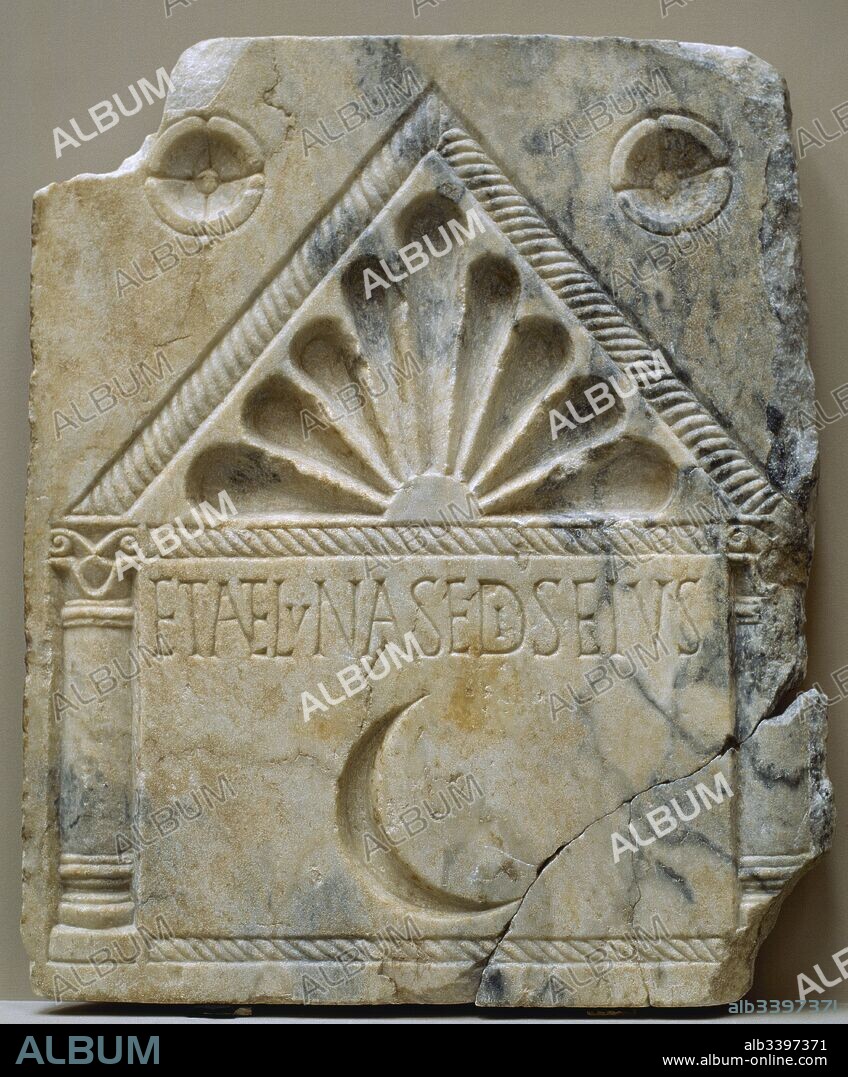alb3397371
Moon Plate. 4th century AD. Marble plaque (60 x 50 cm) that depicts an aediculae, partly engraved and partly in bas-relief, framing the figure of a crescent moon that has been sunk (in the fourth quarter), and the corresponding title in a moon. The aediculae is raised on a low pedestal edged by a cable at the top. At both ends of the cable are columns with an attic base, with a plinth, a smooth shaft and a composite capital. The temple is crowned by a high triangular pediment, bordered on three sides by a cable. Two small rosettes with sunken four petals are placed in the spandrels. From Merida (Spain). National Museum of Roman Art. Merida, Badajoz province, Extremadura, Spain.

|
Ajouter à une autre Lightbox |
|
Ajouter à une autre Lightbox |



Avez-vous déjà un compte? S'identifier
Vous n'avez pas de compte ? S'inscrire
Acheter cette image.
Sélectionnez l'usage:

Légende:
Voir la traduction automatique
Moon Plate. 4th century AD. Marble plaque (60 x 50 cm) that depicts an aediculae, partly engraved and partly in bas-relief, framing the figure of a crescent moon that has been sunk (in the fourth quarter), and the corresponding title in a moon. The aediculae is raised on a low pedestal edged by a cable at the top. At both ends of the cable are columns with an attic base, with a plinth, a smooth shaft and a composite capital. The temple is crowned by a high triangular pediment, bordered on three sides by a cable. Two small rosettes with sunken four petals are placed in the spandrels. From Merida (Spain). National Museum of Roman Art. Merida, Badajoz province, Extremadura, Spain.
Crédit:
Album / Prisma
Autorisations:
Taille de l'image:
3976 x 4802 px | 54.6 MB
Taille d'impression:
33.7 x 40.7 cm | 13.3 x 16.0 in (300 dpi)
Mots clés:
4E SIECLE • 4EME S • ANCIEN • ANTIQUE • ANTIQUITE • ANTIQUITÉS • ARCHÉLOGIE • ARCHEOLOGIE • ARCHÉOLOLOGIE • ART (CATÉGORIE) • ART • ASTROLOGIE • ASTRONOMIE • BAS-RELIEF • BIBELOT • BIBELOTS • DECORATION • DECORATIONS • EPITHAPHE • EUROPE • INSCRIPTION • LUNE • LUSITANIA • MARBRE • MORT STELE FUNERAIRE • ORNEMENT • ORNEMENTS • ORTHOSTAT • PAGANISME • PARURE • PIERRE MARBRE • PIERRE TOMBALE • RELIEF • RELIGION PAIENNE • SCIENCE: ASTROLOGIE • SCIENCE: ASTRONOMIE • SCULPTURE • SCULPTURES • STELE • STELE: FUNERAIRE • STELES, TOUS • TABLETTE AVEC INSCRIPTION • TECHNIQUE: SCULPTURE • TRIANGLE • WISIGOTH • ZODIAQUE, ASTROLOGIE


 Pinterest
Pinterest Twitter
Twitter Facebook
Facebook Copier le lien
Copier le lien Email
Email
